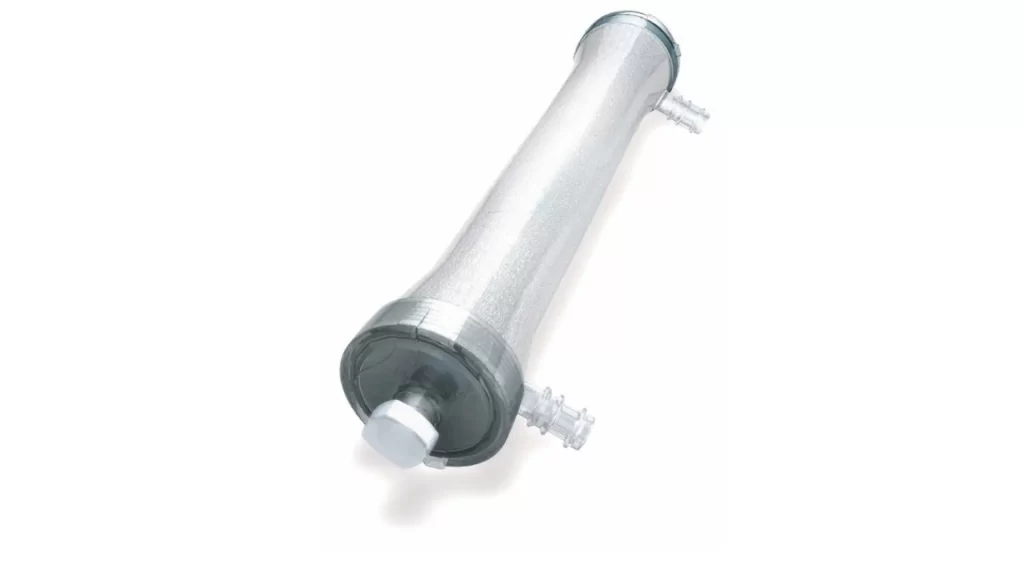Blood filters are critical components in medical devices, ensuring the removal of impurities, clots, and cellular debris to maintain safe and effective blood flow. Despite their essential role, these filters often face challenges such as fouling, thrombosis, and reduced filtration efficiency. This article examines the challenges associated with blood filter performance, the advancements in surface coating technologies—including Smart Reactors’ Camouflage™ coating—and their impact on improving filtration efficiency and hemocompatibility.
Blood filters play a crucial role in medical devices, ensuring the removal of harmful particulates such as microemboli, clots, and cellular debris to protect patients and maintain device functionality. These filters are indispensable in extracorporeal membrane oxygenation (ECMO), dialysis, and cardiopulmonary bypass systems. However, their performance is often limited by complications such as thrombosis, protein fouling, and hemolysis.
To address these challenges, advanced surface coatings have emerged as a transformative solution, enhancing both the filtration efficiency and hemocompatibility of blood filters. Among these innovations, Smart Reactors’ Camouflage™ coating has been specifically designed to tackle issues of thrombogenicity and fouling, providing a new standard in filter performance.
Challenges in Blood Filter Performance
The interaction of blood with filter surfaces can lead to several complications, reducing both the efficiency of filtration and the safety of the patient. One of the primary challenges is thrombosis, where platelet activation on filter surfaces leads to clot formation, obstructing flow, and diminishing filtration capacity.
Protein fouling is another critical issue, where plasma proteins adhere to the filter membrane, clogging pores and reducing its ability to capture impurities. Over time, biofouling further accelerates performance degradation by encouraging microbial colonization. Additionally, mechanical stress within the filter can cause hemolysis, damaging red blood cells and contributing to further complications.
These challenges underscore the need for innovative surface modifications that can address the biological and mechanical interactions at the blood-filter interface

The Role of Surface Coatings
Surface coatings are engineered to enhance the performance and longevity of blood filters by modifying their interaction with blood components. Among the most promising solutions is Smart Reactors’ Camouflage™ coating, which is specifically designed to mimic the properties of natural endothelium, reducing thrombogenicity and promoting hemocompatibility.
- Hydrophilic Coatings: These coatings attract water molecules, creating a hydration layer that prevents protein and platelet adhesion, keeping filter pores open for consistent filtration.
- Camouflage™ Coating: Camouflage works by attracting and retaining a layer of non-inflammatory proteins from the patient’s blood on the device surface – camouflaging the surface and reducing the progression towards clotting.
- Nitric Oxide-Releasing Coatings: By releasing NO, these coatings prevent platelet aggregation and maintain smooth blood flow through the filter.
- Zwitterionic Coatings: Their charge-neutral surfaces repel proteins and microbial adhesion, ensuring that the filter remains clean and functional over extended use.
- Antimicrobial Coatings: These coatings incorporate antimicrobial agents to inhibit microbial colonization, reducing biofilm formation and prolonging filter lifespan.
Impact on Filtration Efficiency and Hemocompatibility
The integration of advanced coatings like Camouflage™ significantly improves the performance of blood filters. These coatings reduce the adhesion of biological materials to the filter surface, preventing clogging and maintaining the open flow paths required for efficient filtration. Their hemocompatible properties minimize thrombosis and immune activation, reducing the risk of complications and improving patient outcomes.
Additionally, anti-fouling and antimicrobial properties extend the operational lifespan of blood filters, reducing the need for frequent replacements and ensuring reliable device functionality.
Applications in Clinical Settings
Coated blood filters are transforming various medical applications by enhancing safety and performance:

- ECMO Systems: Filters with Camouflage™ prevent clots and debris from compromising oxygenator and pump performance, ensuring stable extracorporeal circulation.
- Dialysis: Coated filters maintain consistent clearance of impurities without fouling, enhancing treatment outcomes for patients with renal failure.
- Cardiopulmonary Bypass: By reducing emboli formation and maintaining flow efficiency, Camouflage™-coated filters improve patient safety during high-risk surgical procedures.
- Blood Transfusion: Advanced coatings ensure safer transfusions by reducing clot formation and contamination risks.
Blood filters are indispensable in modern medical practice, ensuring the safe and effective removal of impurities in critical blood-contacting systems. However, challenges such as thrombosis, fouling, and hemolysis can limit their performance. Advanced surface coatings, including Smart Reactors’ Camouflage™, represent a significant breakthrough, addressing these challenges while enhancing filtration efficiency and hemocompatibility.
The development and application of innovative coatings continue to set new standards for blood filter performance, improving both patient outcomes and device reliability.
For more information about Camouflage™ and its applications in blood filters, Contact us.
Share this post: on LinkedIn

